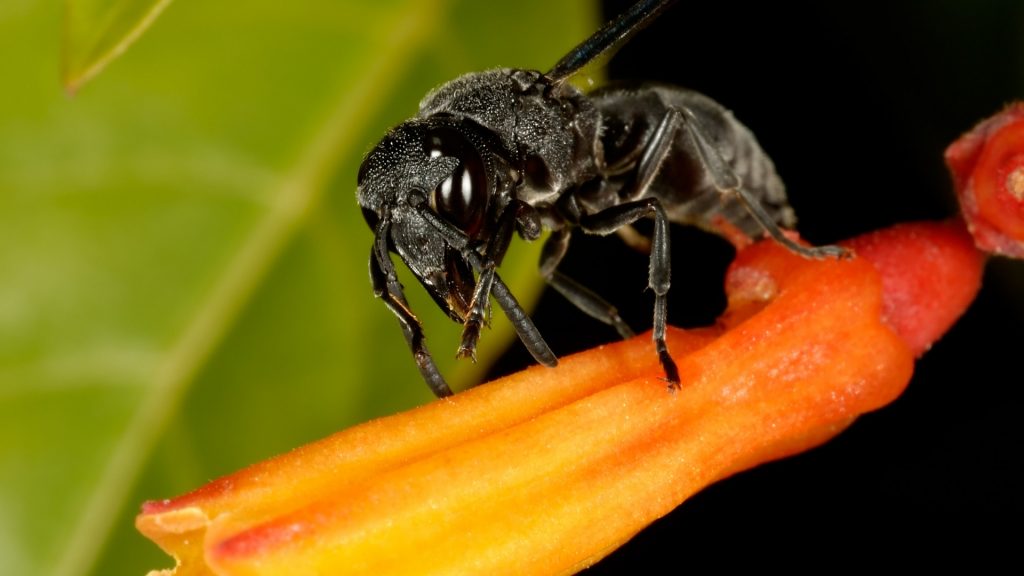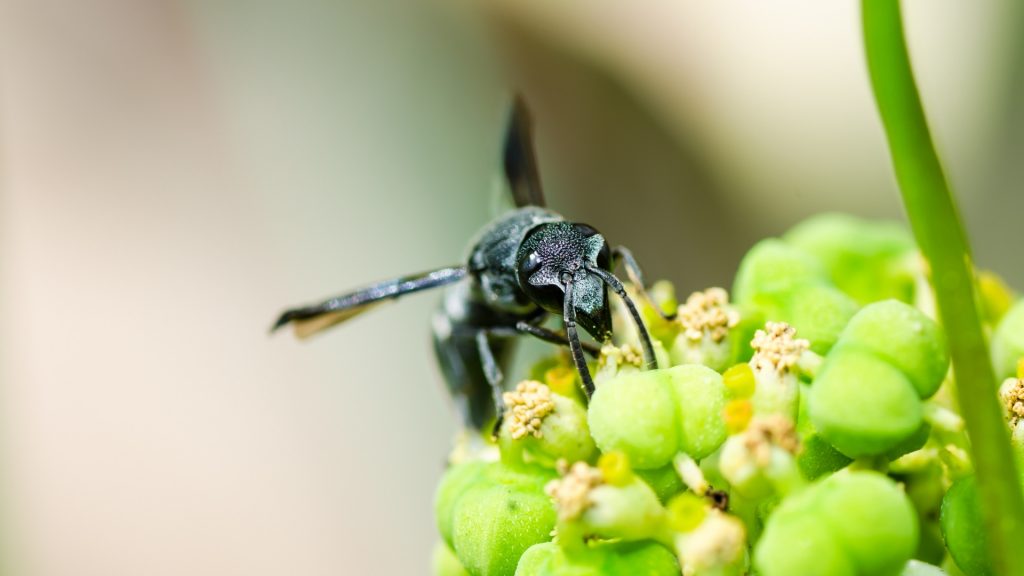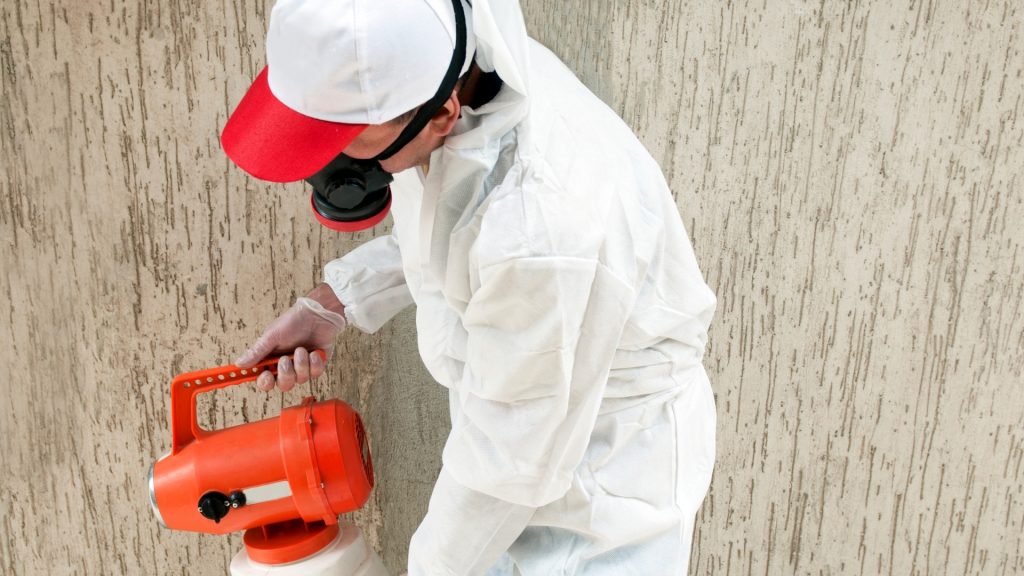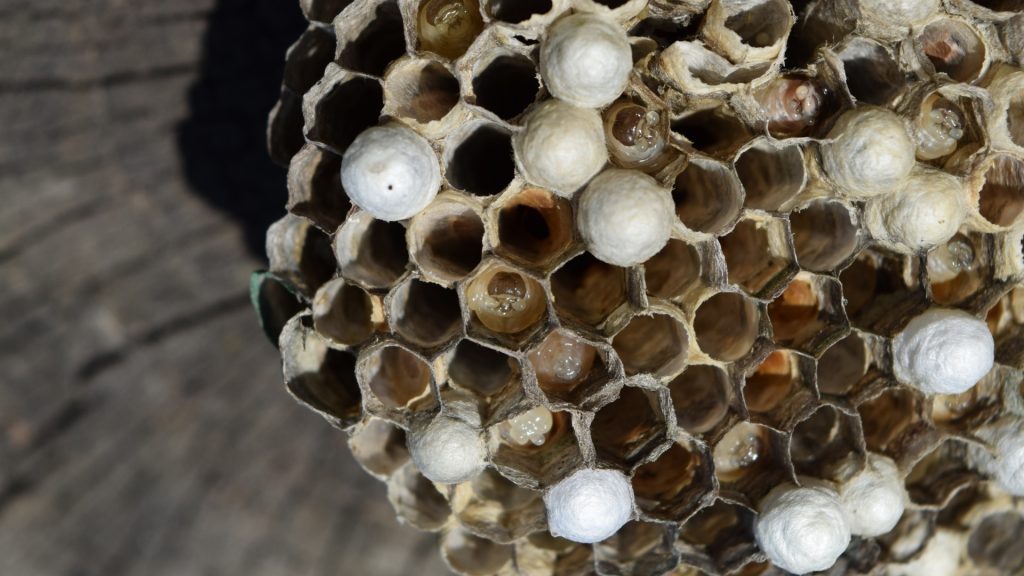Black wasps can be found widely across the United States. They are especially large and can deliver a painful sting when threatened. This is why getting rid of them as soon as you encounter them in your property is essential!
So, how to get rid of a black wasp and prevent it from coming back? First, locate the nests and eliminate food sources. Afterwards, you can employ one or more of the following: setting up traps, applying non-insecticide sprays, using essential oils, and drenching or dusting the nests. Finally, make sure to cover cracks and crevices where they can enter.
This comprehensive guide will go into detail with everything you need to know about properly identifying black wasps, knowing their nature and behavior, and efficiently removing them from the premises. Read further for more!
What Exactly Is a Black Wasp?

Also known as great black wasps, this species belongs to the Sphecidae family which consists of thread-waisted wasps. Black wasps can usually be spotted in flower gardens or open areas with flowers from July to September.
- Scientific Name: Sphex pensylvanicus
- Lifespan: 12 to 22 days (Worker); Up to 1 year (Queen)
- Diet: Primarily insects from the Orthoptera order such as katydids, crickets, and grasshoppers
- Nesting Site: About a foot beneath soft and dry soil
- Characteristics: Communicates by smelling and emitting a chemical called pheromones. It is a solitary species and females are usually alone when digging to create chambers for their nests. It is able to fly at speeds ranging from 7 to 30 miles per hour.
What Does a Black Wasp Looks Like?
Black wasps are between 1 and 1.5 inches long, with females being usually bigger than males. They are a satiny matte black color with a narrow constriction between their abdomen and thorax, large eyes and head, shiny wings, spiny and long legs, and huge sickle-shaped mouthparts.
What Is the Life Cycle of a Black Wasp?
Just like other wasps, the black wasp undergoes a complete metamorphosis from egg, larva, and pupa until it becomes an adult. However, they are solitary wasps which means they don’t live in colonies. Instead, a female will mate with a male and will then dig a hole in the ground.
She will then sting another insect, such as a grasshopper, for food. The female black wasp will drag the dead insect to the hole and lay a single egg on it. She will usually repeat the process in another hole until she has laid a large number of eggs.
Once the larvae are hatched, they will eat the grasshoppers and will soon emerge as adults. They will eventually learn to eat nectar and pollen from various flowers.
Does Black Wasp Have Benefits to the Environment?

While many people consider black wasps to be pests, these small insects offer environmental advantages. They are great pollinators because they transfer pollen, which is essential in helping plants become fertilized.
Aside from that, the black wasp also helps eliminate garden pests such as cicadas, grasshoppers, and katydid. The female black wasp attacks and paralyzes these insects and brings them to their underground nest as food for their young.
Related: Do Wasps Attack at Night? | Important Facts!
Is the Black Wasp Harmful to Humans?
Generally, no. Only the females have a stinger, and they use it only for hunting food for their young. They also do not have to defend others because they do not live in a colony. But, more importantly, they do not sting humans unless they are mistreated or if they are harmed or disturbed.
How to Treat a Black Wasp Sting?
If you have been stung by a black wasp, it is common that you feel some kind of sensation. This includes a sharp pain or burning, followed by itching, redness of the skin, or swelling.
If you are allergic to a wasp sting, the symptoms might be more pronounced but not life-threatening. However, a few hours of pain may be normal.
You can perform the following actions if the symptoms of a wasp sting are severe:
- If the pain or swelling increases for the next 2-3 days, you might need to go to the doctor for further examination.
- You should also consult a doctor if you are already experiencing nausea and vomiting.
- In some cases, you may do some self-medication, such as Benadryl, which can help you reduce the discomfort.
Fortunately, you can also treat a wasp sting if the symptoms are mild and moderate only.
- Step 1: Wash the infected area with soap and water to remove the venom.
- Step 2: To reduce the swelling, you may apply a cold pack to the wound.
- Step 3: Clean and dry the wound and, if necessary, bandage it to prevent further infection. Keep it clean regularly.
Actions to Consider Before Getting Rid of Black Wasp
Always Protect Yourself

Whether the black wasp nest is indoor or outdoor, you have to protect yourself first before taking action. As you probably know by now, the black wasp will only attack if they sense danger, and only the females may sting. Always wear protective clothing and footwear, gloves, and even goggles or safety glasses.
Identify Location of Nests

Identifying the location of the black wasp nests will make it easier and faster for you to get rid of them. In most cases, you will find them outdoors. Aside from soft soil near the plants and bushes, they can also be found in other undisturbed areas.
If you find them inside your house, they are very likely to eat ants and even your sweets, pet food, and leftover foods. They need sweet food and protein in producing eggs.
For indoor nests, you may find them under the windows, overhangs, and underneath sidings. Nevertheless, they are usually fewer in numbers when indoors.
Related: Hornet Nest vs. Wasp Nest | Similarities, Differences, and How to Get Rid of Them
6 Effective Ways to Get Rid of a Black Wasp
The black wasp may not pose a threat to humans and the environment. But if they become unmanageable, it may be time for you to get rid of them. However, it may not be as easy as you think.
They can sense if danger is coming, and they know how to defend their territory. Nevertheless, here are some techniques you can try.
1. Eliminate Their Food Source
So far, the most humane way is to control their food source. Instead of having a flower garden in your backyard, you may plant them indoors. This will surely drive the black wasp away.
You may also seal your trash cans since they are ideal locations for leftover foods and food scraps. Just like ants, wasps love eating such kinds of foods.
Related: What Do Wasps Eat? | Information & Facts
2. Use a Trap or Non-Insecticide Spray
For indoor control, you may want to use a sticky tape trap . Once the black wasp passes through it, it can easily get stuck.
- 👍KGK Sticky traps are glue-based traps which are frequently...
- 👍Made of pesticides-free and non-toxic materials which has no...
- 👍Yellow sticky traps widely capture to trap/monitor most pests...
- 👍The adhesive is waterproof, heat resistant and will not dry...
- ❤️【Great After-Sales Support Guarantee】It can be a...
Another type of trap is to make a nectar-like solution and place it in a container with no cover or lid. Once the wasp gets attracted to the aromatic smell, they will enter the container and be killed instantly.
You may also use non-insecticide spray and make sure they have no harmful chemicals. There are lots of nontoxic mint sprays available in stores, and all of them are equally effective.
- FRESH SCENT: EcoSmart's Natural Wasp And Hornet Killer works with...
- ENVIRONMENTALLY FRIENDLY: Our plant-based formula eliminates...
- CHILD AND PET FRIENDLY: This product is safe to use around kids...
- NO CHEMICALS: Take chemicals out of your lawn, garden and home...
- MADE IN THE USA
In some cases, a simple cleaning spray can do the job or prevent them from flying. Nevertheless, don’t use a fly-swatter; they don’t work well.
3. Use Essential Oils
Essential oils are known to be ideal in exterminating black wasp nests. So far, peppermint oil appears to be the best among them all.
- Step 1: Take a few drops of peppermint oil and mix them with some tablespoons of dishwashing soap.
- Step 2: Add 1 cup of water and mix thoroughly.
- Step 3: Spray the mixture on the known nest and check the result.
If there is no peppermint oil available, you can use other essential oils such as clove oil, geranium oil, cedar oil, or lemon oil. Although you may need a stronger mixture, they can be as effective as peppermint oil. It works best at night when the wasps are sleeping.
Related: Plants That Repel Wasps | Information and Facts
4. Drench Nests With Insecticides
Insecticides , when applied correctly, are certainly effective in eliminating black wasps. They are also great tools in preventing these diggers from coming back.
- PT Wasp-Freeze II Wasp & Hornet Insecticide provides instant...
- The powerful spray can reach up to 15 feet, ensuring safety for...
- Residual activity ensures complete elimination of wasps and...
- Quick knockdown prevents the release of stinging pheromones,...
- Read, understand, and follow the label safety, application,...
However, most insecticides contain hazardous chemicals and should not be used inside the house, especially if you have elderly, small children, or people with asthma.
To protect yourself against toxic chemicals, you can do the following:
- Make sure you wear the correct PPE (Personal Protective Equipment).
- If possible, use a spray that can shoot up to 20-22 feet away from you.
- Stand away from the nest as far as possible, and create a steady stream of the spray to fully drench the nest. This will surely drown the stubborn black wasps.
5. Dust the Nests
This method also uses insecticides . But instead of spray or liquid chemicals, you will be using powder. With this technique, the risk of toxic chemicals dispersing in the air is reduced but, you still need to wear the proper PPE.
- Delta Dust Bed Bug Insecticide - 1 lb.
- Yield: 1 lb. of Delta Dust covers about 2,000 sq.ft.
- Target Pest: Ants, Bed Bugs, Boxelder Bugs, Cockroaches,...
- Active Ingredient: Deltamethrin, 0.05%
- Cannot ship to NY or CT.
Simply sprinkle the powder (dust) into the nest and leave it alone. However, dusting the nest in the ground may require you to do it repeatedly. It may also take a few days for all of the eggs to be killed and the nest destroyed.
Likewise, this method works best if the nest is still small and wasp infestation does not yet pose an immediate threat. In severe cases, spraying insecticides is a better solution.
6. Cover the Holes and Cracks
Look for some small holes in your landscape or property then cover them with gravel and soil so the black wasps will get stuck inside their nest and will eventually die. This will also prevent the queen black wasp to lay eggs in that area again.
On the other hand, small cracks inside the house are also ideal for black wasp nests. Although they seldom invade a house, these flying creatures may accidentally enter your house through openings or small holes. The best time to cover it is late fall or early spring when they are less active.
List of Sources
Baxendale, F. P., Kamble, S. T., & Ellis, M. D. (2008). Stinging Wasps and Bees.
Missouri Department of Conservation. (n.d.). Great Black Wasp.
The Bug Lady. (2010). Great Black Wasp (Family Sphecidae).
Waddick, P. (2021). Great Black Wasp, Sphex pensylvanicus.
- Bed Bug Surge 2025: How to Detect, Prevent, and Safely Eliminate Infestations in Top U.S. Cities - June 18, 2025
- Asian Needle Ants Invade US Homes: 2025 Guide to Identification, Risks, and Effective Control - June 11, 2025
- New World Screwworm Alert: How US Livestock Owners Can Prevent Outbreaks and Protect Herds [Summer 2025 Update] - June 8, 2025




